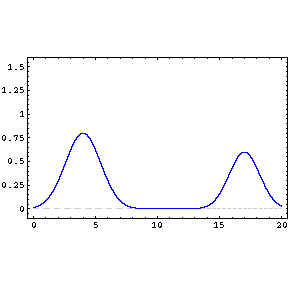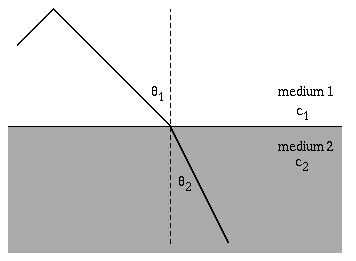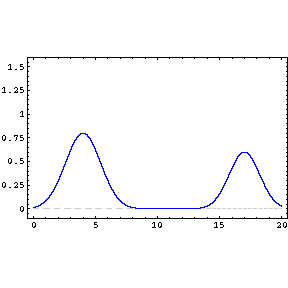Physics- Light And Sound Waves Quiz!

In our physics class, we got to dive deeper into the topic of waves, light, and sound. With the scheduled monthly test coming up, it is important to ensure you are on your feet when it comes to what we have covered so far. Give it a shot and see if you should hit the books one last time before the test!
- 1.
In this animation, what type of wave is shown?
- A.
Transverse
- B.
Refracted
- C.
Longitudinal
- D.
Light
Correct Answer
C. LongitudinalExplanation
The animation shown in the question depicts a wave that moves in the same direction as the disturbance it carries. This type of wave is known as a longitudinal wave. Unlike transverse waves, longitudinal waves have their particles oscillating parallel to the direction of the wave's motion. Refracted waves refer to waves that change direction when passing through different mediums, while light is a form of electromagnetic wave.Rate this question:
-
- 2.
The material that a wave travels through is called the
- A.
Refraction
- B.
Medium
- C.
Reflection
- D.
Speed
Correct Answer
B. MediumExplanation
The correct answer is "medium". A wave travels through a material known as a medium. A medium can be any substance or space that allows the wave to propagate. It can be a solid, liquid, gas, or even a vacuum. The properties of the medium, such as density and elasticity, determine how the wave behaves and travels through it.Rate this question:
-
- 3.
The type of wave shown is a __________ wave.
Correct Answer
transverse, transverse waveExplanation
The type of wave shown is a transverse wave. Transverse waves are characterized by the oscillation of particles perpendicular to the direction of wave propagation. In this type of wave, the particles move up and down or side to side, creating crests and troughs. Examples of transverse waves include light waves and electromagnetic waves.Rate this question:
- 4.
In this animation what kind of interference is shown?
- A.
Destructive
- B.
Constructive
- C.
Refraction
- D.
Reflection
Correct Answer
B. ConstructiveExplanation
The animation is showing constructive interference. Constructive interference occurs when two or more waves meet and their amplitudes add together, resulting in a wave with a larger amplitude. In the animation, it can be observed that the waves are overlapping and reinforcing each other, creating a wave with a higher amplitude at certain points. This is characteristic of constructive interference.Rate this question:
-
- 5.
____________ is when a wave, like light, bounces off an object.
Correct Answer
ReflectionExplanation
Reflection is when a wave, like light, bounces off an object. Reflection is the phenomenon where a wave encounters an object or surface and bounces back, following the law of reflection. This process allows us to see objects in mirrors, hear echoes, and understand the behavior of light when it interacts with various surfaces.Rate this question:
- 6.
What property of waves is shown in the animation?
Correct Answer
refraction, refractingExplanation
The animation shows the property of waves known as refraction or refracting. Refraction occurs when a wave passes from one medium to another and changes direction due to the change in its speed. In the animation, the wave appears to bend as it enters a different medium, indicating the phenomenon of refraction.Rate this question:
- 7.
Which of the following is not a type of electromagnetic wave?
- A.
Sound
- B.
Red light
- C.
Gamma rays
- D.
Radio waves
- E.
Microwaves
Correct Answer
A. SoundExplanation
Sound is not a type of electromagnetic wave. Unlike electromagnetic waves, sound waves require a medium, such as air or water, to travel through. Electromagnetic waves, on the other hand, can travel through a vacuum, such as in space. Sound waves are mechanical waves caused by the vibration of particles, while electromagnetic waves are made up of oscillating electric and magnetic fields.Rate this question:
-
- 8.
All waves except __________ waves must travel through a medium.
- A.
Sound
- B.
Light
- C.
Water
- D.
Compressional
Correct Answer
B. LightExplanation
All waves except light waves must travel through a medium because light waves are electromagnetic waves that can travel through a vacuum. Unlike sound waves, which require a medium such as air, water waves, which require a medium such as water, and compressional waves, which require a medium for propagation, light waves can travel through empty space due to their unique nature as electromagnetic radiation.Rate this question:
-
- 9.
Points A and F onthe wave are ________
Correct Answer
crest, crestsExplanation
A crest is the highest point of a wave, while crests refer to multiple high points of waves. Therefore, points A and F on the wave are both high points or crests of the wave.Rate this question:
- 10.
Points B, E, G, and J on the wave are _______________.
Correct Answer
node, nodesExplanation
Points B, E, G, and J on the wave are referred to as nodes. In a wave, nodes are the stationary points where the amplitude of the wave is zero. These points do not experience any displacement as the wave passes through them. In this case, B, E, G, and J are the specific points on the wave where this occurs, making them nodes.Rate this question:
- 11.
Points D and I on the wave are __________________.
Correct Answer
trough, troughsExplanation
Points D and I on the wave are located at the lowest points of the wave, known as troughs. In a wave, the crest represents the highest point and the trough represents the lowest point. Therefore, both points D and I on the wave are troughs.Rate this question:
- 12.
The distance between A and F is the _____________.
- A.
Frequency
- B.
Period
- C.
Amplitude
- D.
Wavelength
Correct Answer
D. WavelengthExplanation
The distance between A and F is referred to as the wavelength. Wavelength is a term used to describe the length of one complete cycle of a wave. In this context, it represents the distance between two points on a wave where the wave pattern repeats itself. It is commonly measured in meters or any other unit of length.Rate this question:
-
- 13.
The distance from the dotted line to Point A, or the distance from the dotted line to Point D is known as the ______________.
- A.
Frequency
- B.
Period
- C.
Amplitude
- D.
Wavelength
Correct Answer
C. AmplitudeExplanation
The distance from the dotted line to Point A, or the distance from the dotted line to Point D is known as the amplitude. Amplitude measures the maximum displacement or distance from the equilibrium position of a wave. It represents the intensity or strength of the wave. In this context, the dotted line represents the equilibrium position, and the distance from the dotted line to either Point A or Point D represents the amplitude of the wave.Rate this question:
-
- 14.
this image shows an example of:
- A.
Reflection
- B.
Refraction
- C.
Penumbra
- D.
A broken straw
Correct Answer
B. RefractionExplanation
This image shows an example of refraction. Refraction occurs when light passes through a medium and changes direction. In this image, it is likely that the light is passing through a transparent material, such as water or glass, causing the bending of the light rays. This bending phenomenon is known as refraction.Rate this question:
-
- 15.
The wave speed equation is v = frequency x wavelength.If the velocity of the wave is 400 m/s and the wavelength is 2m, what is its frequency?
- A.
200 Hz
- B.
800 Hz
- C.
20 Hz
- D.
400 Hz
Correct Answer
A. 200 HzExplanation
The wave speed equation states that the velocity of a wave is equal to the product of its frequency and wavelength. In this question, the given wave has a velocity of 400 m/s and a wavelength of 2m. To find the frequency, we can rearrange the equation to solve for frequency. Dividing the velocity by the wavelength gives us a frequency of 200 Hz.Rate this question:
-
- 16.
In this example of constructive interference, what increases?
- A.
Wavelength
- B.
Frequency
- C.
Speed
- D.
Amplitude
Correct Answer
D. AmplitudeExplanation
In constructive interference, two waves combine to form a wave with a larger amplitude. This means that the height or intensity of the resulting wave increases compared to the individual waves. Therefore, in this example of constructive interference, the amplitude increases.Rate this question:
-
Quiz Review Timeline +
Our quizzes are rigorously reviewed, monitored and continuously updated by our expert board to maintain accuracy, relevance, and timeliness.
-
Current Version
-
Feb 02, 2024Quiz Edited by
ProProfs Editorial Team -
Oct 24, 2008Quiz Created by
Dbynagle
- Acceleration Quizzes
- Acoustic Quizzes
- Chapters Of Physics Quizzes
- Distance Quizzes
- Electrolysis Quizzes
- Energy Quizzes
- ESD Quizzes
- Frequency Quizzes
- Light And Reflection Quizzes
- Logic Gate Quizzes
- Magnetic Field Quizzes
- Momentum Quizzes
- Motion Quizzes
- Online Physics Quizzes
- Optics Quizzes
- Physics Of Sound Quizzes
- Practice Physics Quizzes
- Properties Of Matter Quizzes
- Quantum Quizzes
- Quantum Physics Quizzes
- Reflection Quizzes
- Refraction Quizzes
- Secondary 3 Physics Quizzes
- Speed Of Light Quizzes
- Thermodynamics Quizzes
- Velocity Quizzes
- Work And Energy Quizzes
 Back to top
Back to top













